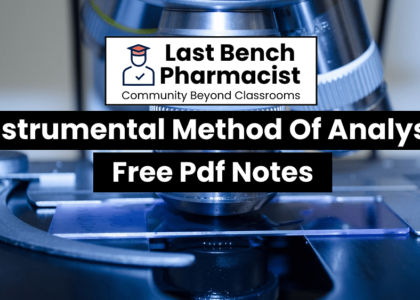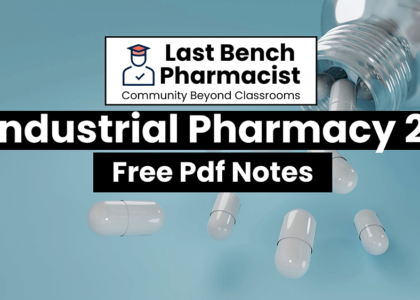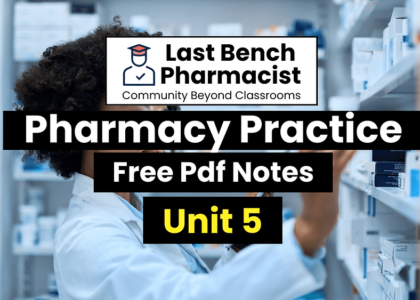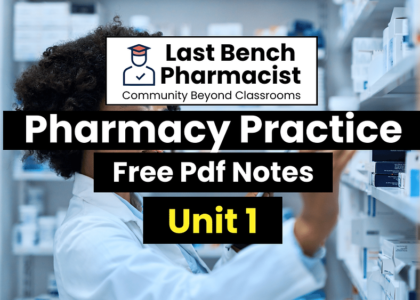
B Pharm Pharmacy Practice PDF Notes
#bpharmnotes #bpharmIndustrialPharmacynotes #bpharmpdfnotes
B-Pharmers, get ready to step into the exciting world of B Pharm Pharmacy Practice PDF Notes! This unit equips you to be a medication expert, bridging the gap between science and patient care. Imagine being the trusted advisor, guiding individuals on safe and effective medication use. We’ll explore dispensing medications, understanding prescriptions, and providing evidence-based counseling. Buckle up as we delve into patient communication, learning how to clearly explain complex information and build trust. From understanding drug interactions to managing chronic conditions, we’ll cover it all. Remember, it’s not just about medications; it’s about empowering patients to make informed decisions about their health. By the end of this unit, you’ll be equipped to make a real difference in people’s lives, ensuring they get the most out of their medications and achieve optimal health outcomes.
Scope
In the changing scenario of pharmacy practice in India, for successful practice of Hospital Pharmacy, the students are required to learn various skills like drug distribution, drug information, and therapeutic drug monitoring for improved patient care. In community pharmacy, students will be learning various skills such as dispensing of drugs, responding to minor ailments by providing suitable safe medication, patient counselling for improved patient care in the community set up. This course is designed to impart fundamental knowledge on pharmaceutical product development and translation from laboratory to market
Objectives:-
Upon completion of the subject student shall be able to
Know various drug distribution methods in a hospital
Appreciate the pharmacy stores management and inventory control
Monitor drug therapy of patient through medication chart review and clinical review
Obtain medication history interview and counsel the patients
Identify drug related problems
Detect and assess adverse drug reactions
Interpret selected laboratory results (as monitoring parameters in therapeutics) of specific disease states
Know pharmaceutical care services
Do patient counseling in community pharmacy;
Appreciate the concept of Rational drug therapy.
B Pharm Pharmacy Practice PDF Notes
Unit 1
a) Hospital and it’s organization
Definition, Classification of hospital- Primary, Secondary and Tertiary hospitals, Classification based on clinical and non- clinical basis, Organization Structure of a Hospital, and Medical staffs involved in the hospital and their functions.
b) Hospital pharmacy and its organization
Definition, functions of hospital pharmacy, Organization structure, Location, Layout and staff requirements, and Responsibilities and functions of hospital pharmacists.
c) Adverse drug reaction
Classifications – Excessive pharmacological effects, secondary pharmacological effects, idiosyncrasy, allergic drug reactions, genetically determined toxicity, toxicity following sudden withdrawal of drugs, Drug interaction- beneficial interactions, adverse interactions, and pharmacokinetic drug interactions, Methods for detecting 149 drug interactions, spontaneous case reports and record linkage studies, and Adverse drug reaction reporting and management.
d) Community Pharmacy
Organization and structure of retail and wholesale drug store, types and design, Legal requirements for establishment and maintenance of a drug store, Dispensing of proprietary products, maintenance of records of retail and wholesale drug store.
Unit 2
a) Drug distribution system in a hospital
Dispensing of drugs to inpatients, types of drug distribution systems, charging policy and labelling, Dispensing of drugs to ambulatory patients, and Dispensing of controlled drugs.
b) Hospital formulary
Definition, contents of hospital formulary, Differentiation of hospital formulary and Drug list, preparation and revision, and addition and deletion of drug from hospital formulary.
c) Therapeutic drug monitoring
Need for Therapeutic Drug Monitoring, Factors to be considered during the Therapeutic Drug Monitoring, and Indian scenario for Therapeutic Drug Monitoring.
d) Medication adherence
Causes of medication non-adherence, pharmacist role in the medication adherence, and monitoring of patient medication adherence.
e) Patient medication history interview
Need for the patient medication history interview, medication interview forms
f) Community pharmacy management
Financial, materials, staff, and infrastructure requirements.
Unit 3
a) Pharmacy and therapeutic committee
Organization, functions, Policies of the pharmacy and therapeutic committee in including drugs into formulary, inpatient and outpatient prescription, automatic stop order, and emergency drug list preparation.
b) Drug information services
Drug and Poison information centre, Sources of drug information, Computerised services, and storage and retrieval of information.
c) Patient counseling
Definition of patient counseling; steps involved in patient counseling, and Special cases that require the pharmacist
d) Education and training program in the hospital
Role of pharmacist in the education and training program, Internal and external training program, Services to the nursing homes/clinics, Code of ethics for community pharmacy, and Role of pharmacist in the interdepartmental communication and community health education.
e) Prescribed medication order and communication skills
Prescribed medication order- interpretation and legal requirements, and Communication skills- communication with prescribers and patients
Unit 4
a) Budget preparation and implementation
Budget preparation and implementation
b) Clinical Pharmacy
Introduction to Clinical Pharmacy, Concept of clinical pharmacy, functions and responsibilities of clinical pharmacist, Drug therapy monitoring – medication chart review, clinical review, pharmacist intervention, Ward round participation, Medication history and Pharmaceutical care. Dosing pattern and drug therapy based on Pharmacokinetic & disease pattern.
c) Over the counter (OTC) sales
Introduction and sale of over the counter, and Rational use of common over the counter medications.
Unit 5
a) Drug store management and inventory control
Organisation of drug store, types of materials stocked and storage conditions, Purchase and inventory control: principles, purchase procedure, purchase order, procurement and stocking, Economic order quantity, Reorder quantity level, and Methods used for the analysis of the drug expenditure
b) Investigational use of drugs
Description, principles involved, classification, control, identification, role of hospital pharmacist, advisory committee.
c) Interpretation of Clinical Laboratory Tests
Blood chemistry, hematology, and urinalysis





